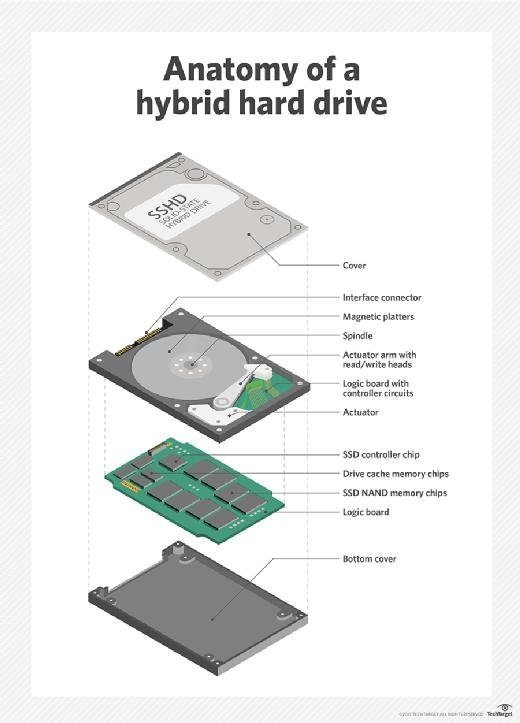hybrid hard drive (HHD)
What is a hybrid hard drive?
A hybrid hard drive (HHD) is a mass storage device that combines a conventional hard disk drive (HDD) and a NAND flash memory module. An HHD, sometimes known as a solid-state hybrid drive (SSHD), combines the capacity, cost and performance of physical disk storage with the accelerated performance of flash.
Data that's frequently written to or retrieved from storage is served from flash memory. Samsung, Seagate Technology, Toshiba and Western Digital offer variants of HHD technology, typically branded with the SSHD label. These drives are often used consumer devices, such as in laptop computers. PC gaming devices also use SSHDs. Their large applications can be stored on the HDD while the solid-state component is used for high-speed access.

Hybrid hard drives vs. solid-state drives vs. hard drives
Hybrid hard drives bridge the gap between flash and fixed-disk magnetic storage. Solid-state drives (SSDs) are faster than traditional spinning disks, have no moving parts and have greater durability. They also have more storage capacity and better performance than traditional HDDs. Owing to advances in technology, the reliability of all three types of drives is comparable. As with any storage solution, the user requirements play a key role in deciding which technology is appropriate.
An HDD uses stacks of electromechanical spinning platters to store nonsequential data, written to sectors within specified blocks on each disk via an actuator arm. The HDD controller positions a hard disk, so data is read and written on the correct disk sector. The HDD mechanism and hard disk are packaged as an integrated unit, although both terms are used to describe it.
Engineers at IBM in the 1950s created the hard disk to provide random access to high capacities of data. Doing so at an affordable cost was one of IBM's key design criteria. Disk density has increased greatly from IBM's original 3.75 megabyte (MB) device.
HDDs today have reached 30 terabytes (TBs), with higher-capacity drives primarily targeting data center implementations. At the consumer level, several 22 TB drives represent the current upper limit of hard drive capacities.
SSD upper capacity limits reach 100 TB for data-center devices and 60 TBs for consumer devices. Most consumer SSD products average 2 TB to 8 TB.
An example of a typical SSHD is the Seagate FireCuda, with up to 2 TB of HDD storage and a cache with 8 GB of solid-state storage. The cache learns which data is used the most frequently and holds it in the flash memory to make it available for fast access.
HDDs connect to computing devices via a serial-attached Small Computer System Interface (SAS) or Serial Advanced Technology Attachment (SATA) interface. Similarly, SSDs -- also known as flash drives -- are based on SAS or SATA form factors and use those physical interfaces, but they have no internal mechanical movement.
SSDs consist of silicon chips designed as an integrated circuit to provide non-volatile memory for resilience. This differs from volatile cache storage on HDDs, which require an onboard capacitor or battery backup to protect data in the event of a system failure.
A hybrid hard drive adds a small dose of flash to the core disk architecture. The NAND cache buffer stores hot data and serves it to disk to accelerate application workloads. A typical HHD cache volume contains about 8 GB of flash and requires no special software driver.
A hybrid hard drive with embedded flash costs less than an SSD but can yield similar performance. Prices for HHDs are closer to those of regular hard disk drives as the technologies and manufacturing processes improve.
Pros and cons of hybrid storage products
Hybrid hard drives deliver advantages compared to conventional hard drives:
- Faster data storage and retrieval for applications such as word processors.
- Reduced system boot time.
- Lower power consumption.
- Less heat generation.
- Extended hard drive life.
- Longer battery life for notebooks and other portable devices.
- Less operating noise.
HHDs also have some limitations:
- Longer seek times for data stored on the hard drive.
- More frequent HDD spin up and spin down.
- Data loss and other problems with data recovery from failed flash memory modules.
- Somewhat higher overall hardware cost for the system.
Hybrid flash overshadows hybrid hard drives
Integrating flash storage directly on disk was conceived to speed up data access across all storage. The combination of low cost and high performance led industry analysts to believe hybrid hard drives eventually would supplant traditional hard drives and even provide a solid alternative to SSDs. However, technological advances have leveled the playing field, particularly with features and competitive pricing, with users as the ultimate benefactors.
One reason for the market shift is the emergence of hybrid arrays, a type of hierarchical storage that mixes SSDs and magnetic disk at the storage drive level. This functionality allows vendors to build arrays from commercial off-the-shelf hardware, with intelligent software to manage caching and data tiering.
The future of HHD technology
The majority of HHD shipments are oriented toward the cloud computing and archival markets. Hybrid hard drives were originally designed to slot in between SSD and HDD technology. However, they're increasingly a less attractive alternative to SSD storage systems as prices per gigabyte for flash storage decline. Users whose primary requirement is for speed are likely to use SSD drives rather than HHDs.
Future technology advancements might keep the door open for HHDs, where users need a particular balance of speed and storage capacity.
Learn more about SSD performance benchmarks, particularly response time, in our SSD performance premier.





